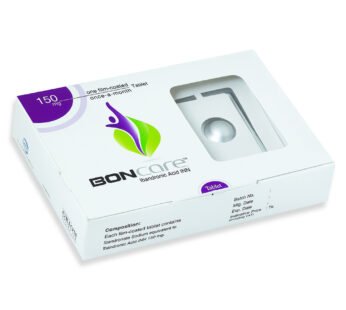Anset 8 mg

Description
Indications Anset is a serotonin subtype 3 (5-HT3) receptor antagonist used for:
- Preventing nausea and vomiting caused by initial and repeat courses of emetogenic cancer chemotherapy.
- Preventing and treating post-operative nausea and vomiting.
- Preventing nausea and vomiting induced by radiotherapy.
Description Anset oral soluble film is an orally dissolving film designed for application on the tongue, where it dissolves within 20 seconds and is then swallowed with saliva. This formulation does not require water for dissolution or swallowing. The active ingredient in Anset is Ondansetron base, which is the racemic form of Ondansetron, a selective 5-HT3 receptor antagonist. The empirical formula is C18H19N3O, with a molecular weight of 293.3.
Pharmacology Ondansetron is a potent and highly selective 5-HT3 receptor antagonist. While its exact mechanism in controlling nausea and vomiting is not fully understood, chemotherapeutic agents and radiotherapy are known to release serotonin (5-HT) in the small intestine. This process triggers a vomiting reflex by activating vagal afferents via 5-HT3 receptors. Ondansetron blocks this reflex at both peripheral and central nervous system sites. It is also believed that vagal stimulation releases serotonin in the area postrema, located on the floor of the fourth ventricle, contributing to emesis through a central mechanism. Ondansetron is effective in managing nausea and vomiting caused by cytotoxic chemotherapy and radiotherapy by antagonizing 5-HT3 receptors. The exact mechanism for post-operative nausea and vomiting is unclear but is thought to involve similar pathways.
Dosage and Administration Chemotherapy-Induced Nausea and Vomiting:
- Adults and Pediatric Patients (6 months to 18 years):
- Tablet or Orodispersible Tablet (8 mg, 4 mg): Three 0.15 mg/kg doses, with a maximum of 16 mg per dose.
- Injection: Three 0.15 mg/kg doses, up to a maximum of 16 mg per dose, administered intravenously over 15 minutes.
Radiotherapy-Induced Nausea and Vomiting:
- Adults:
- Tablet or Orodispersible Tablet (8 mg, 4 mg):
- Initial Dose: 8 mg orally 1 to 2 hours before radiotherapy.
- Post-Radiotherapy: 8 mg orally every 8 hours for up to 5 days.
- Injection: Three 0.15 mg/kg doses, up to a maximum of 16 mg per dose, administered intravenously over 15 minutes.
- Tablet or Orodispersible Tablet (8 mg, 4 mg):
Postoperative Nausea and Vomiting:
- Adults:
- Tablet or Orodispersible Tablet (8 mg, 4 mg): 16 mg in divided doses.
- Injection: 4 mg.
- Pediatrics (>40 kg): Injection: 4 mg.
- Pediatrics (<40 kg): Injection: 0.1 mg/kg.
Oral Soluble Film Administration:
- Tear the pouch along the marked edge.
- Place the film on the tongue, where it dissolves within 20 seconds.
- Do not chew or swallow the film whole.
- Swallow the dissolved film with or without liquid.
- Wash hands after administration.
Interactions Anset does not significantly induce or inhibit cytochrome P-450 liver enzymes. However, drugs that induce or inhibit hepatic cytochrome P-450 enzymes may affect the metabolism and clearance of Ondansetron. No dosage adjustment is required based on available data.
Contraindications
- Hypersensitivity to Ondansetron or any of its components.
- Concurrent use with apomorphine.
Side Effects Common side effects include headache, constipation, and diarrhea, which are generally mild to moderate. Rash has been reported in approximately 1% of chemotherapy-induced nausea and vomiting cases. Other reported effects include flushing, warmth sensation, hiccups, and liver enzyme abnormalities. Rarely, cases of anaphylaxis, bronchospasm, tachycardia, angina, hypokalemia, and shortness of breath have been noted. Extrapyramidal reactions are uncommon, though isolated reports of oculogyric crisis and dystonic reactions exist.
Pregnancy & Lactation Animal studies have shown no evidence of carcinogenicity or mutagenicity. No adverse effects on fertility or reproduction have been observed in rats and rabbits at high doses. However, well-controlled studies in pregnant women are lacking. Ondansetron is excreted in the breast milk of rats, so caution is advised when administering to nursing mothers.
Precautions & Warnings
- Hypersensitivity reactions have been reported in patients sensitive to other 5-HT3 receptor antagonists.
- Anset does not stimulate gastrointestinal motility and should not replace nasogastric suction.
- Use with caution in patients with chemotherapy-induced nausea and vomiting, as it may mask progressive ileus or gastric distension.
Use in Special Populations
- Renal Impairment: No dosage adjustment required.
- Hepatic Impairment: In severe cases, a maximum daily dose of 8 mg is recommended.
- Pediatric Patients (Under 4 Years): Limited dosage information available.
- Elderly Patients (Over 65 Years): No dosage adjustment required.
Therapeutic Class Anti-emetic drugs.
Storage Conditions Store in a dry place at a temperature not exceeding 30°C. Protect from light and moisture.
Additional information
| Weight | 0.15 g |
|---|






Reviews
There are no reviews yet.